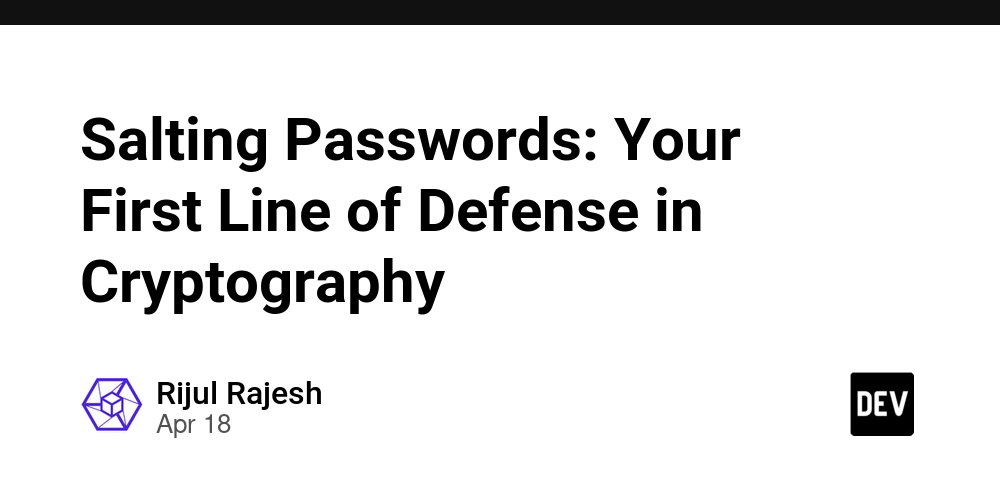Salting Passwords: Your First Line of Defense in Cryptography
When you think of "salting," you might imagine seasoning your fries or adding a dash to your soup. But in the world of cryptography, salting has a very different—and much more important—meaning. If you’ve ever created a password for an app, a website, or a service, there’s a good chance that a little cryptographic magic happened behind the scenes to protect it. One of the unsung heroes of that magic? Salt. The Problem with Plain Passwords Imagine you run a website, and you store users’ passwords in plain text in your database. If someone gains access to your database, they now have all your users’ passwords—just like that. Even if you’re hashing passwords (i.e., converting them into a fixed-length string using something like SHA-256), you’re not out of the woods yet. Why? Because of something called a dictionary attack or rainbow table attack. These attacks involve precomputed lists of hashes for commonly used passwords. If someone can match a hash in your database to one in their list, they’ve cracked the password. Salt: Your Password's Secret Spice Salting is a way to prevent attackers from using precomputed hashes. When a user creates a password, the system generates a random string—this is the salt. The system combines the salt with the password before hashing it. The resulting hash is stored along with the salt. Now, even if two users have the same password, they’ll end up with different hashes. That’s the key! A Simple Example Let’s say Alice and Bob both choose the password password123. Without salting, hashing might look like this: Hash("password123") = e99a18c428cb38d5f260853678922e03 Both users would have the same hash stored in the database—a big vulnerability! With salting: Alice's salt = "X1A2B3" Bob's salt = "Z9Y8X7" Alice's hash = Hash("X1A2B3password123") Bob's hash = Hash("Z9Y8X7password123") Now the hashes are different, even though the passwords are the same. Why Salting Works Salting makes it impractical for attackers to use precomputed hash tables (rainbow tables), because the salt alters the input. Every password becomes unique—even common ones like 123456. This forces attackers to brute-force each password individually, which is extremely time-consuming and resource-intensive. Wrapping up Salting is like giving every password its own secret spice. It’s not a complete security solution on its own, but it’s a crucial ingredient in the recipe for safe password storage. So the next time someone mentions "salting passwords," you’ll know they’re not seasoning their security—they’re strengthening it. If you're a software developer who enjoys exploring different technologies and techniques like this one, check out LiveAPI. It’s a super-convenient tool that lets you generate interactive API docs instantly. So, if you’re working with a codebase that lacks documentation, just use LiveAPI to generate it and save time! You can instantly try it out here!

When you think of "salting," you might imagine seasoning your fries or adding a dash to your soup. But in the world of cryptography, salting has a very different—and much more important—meaning.
If you’ve ever created a password for an app, a website, or a service, there’s a good chance that a little cryptographic magic happened behind the scenes to protect it. One of the unsung heroes of that magic? Salt.
The Problem with Plain Passwords
Imagine you run a website, and you store users’ passwords in plain text in your database. If someone gains access to your database, they now have all your users’ passwords—just like that.
Even if you’re hashing passwords (i.e., converting them into a fixed-length string using something like SHA-256), you’re not out of the woods yet.
Why? Because of something called a dictionary attack or rainbow table attack.
These attacks involve precomputed lists of hashes for commonly used passwords. If someone can match a hash in your database to one in their list, they’ve cracked the password.
Salt: Your Password's Secret Spice
Salting is a way to prevent attackers from using precomputed hashes.
- When a user creates a password, the system generates a random string—this is the salt.
- The system combines the salt with the password before hashing it.
- The resulting hash is stored along with the salt.
Now, even if two users have the same password, they’ll end up with different hashes. That’s the key!
A Simple Example
Let’s say Alice and Bob both choose the password password123.
Without salting, hashing might look like this:
Hash("password123") = e99a18c428cb38d5f260853678922e03
Both users would have the same hash stored in the database—a big vulnerability!
With salting:
Alice's salt = "X1A2B3"
Bob's salt = "Z9Y8X7"
Alice's hash = Hash("X1A2B3password123")
Bob's hash = Hash("Z9Y8X7password123")
Now the hashes are different, even though the passwords are the same.
Why Salting Works
Salting makes it impractical for attackers to use precomputed hash tables (rainbow tables), because the salt alters the input. Every password becomes unique—even common ones like 123456.
This forces attackers to brute-force each password individually, which is extremely time-consuming and resource-intensive.
Wrapping up
Salting is like giving every password its own secret spice. It’s not a complete security solution on its own, but it’s a crucial ingredient in the recipe for safe password storage.
So the next time someone mentions "salting passwords," you’ll know they’re not seasoning their security—they’re strengthening it.
If you're a software developer who enjoys exploring different technologies and techniques like this one, check out LiveAPI. It’s a super-convenient tool that lets you generate interactive API docs instantly.
So, if you’re working with a codebase that lacks documentation, just use LiveAPI to generate it and save time!
You can instantly try it out here!









































































































































































![[The AI Show Episode 144]: ChatGPT’s New Memory, Shopify CEO’s Leaked “AI First” Memo, Google Cloud Next Releases, o3 and o4-mini Coming Soon & Llama 4’s Rocky Launch](https://www.marketingaiinstitute.com/hubfs/ep%20144%20cover.png)




























































































































![[DEALS] The All-in-One Microsoft Office Pro 2019 for Windows: Lifetime License + Windows 11 Pro Bundle (89% off) & Other Deals Up To 98% Off](https://www.javacodegeeks.com/wp-content/uploads/2012/12/jcg-logo.jpg)



























![Is this too much for a modular monolith system? [closed]](https://i.sstatic.net/pYL1nsfg.png)






















































































































_Andreas_Prott_Alamy.jpg?width=1280&auto=webp&quality=80&disable=upscale#)
































































































![What features do you get with Gemini Advanced? [April 2025]](https://i0.wp.com/9to5google.com/wp-content/uploads/sites/4/2024/02/gemini-advanced-cover.jpg?resize=1200%2C628&quality=82&strip=all&ssl=1)













![Apple Shares Official Trailer for 'Long Way Home' Starring Ewan McGregor and Charley Boorman [Video]](https://www.iclarified.com/images/news/97069/97069/97069-640.jpg)
![Apple Watch Series 10 Back On Sale for $299! [Lowest Price Ever]](https://www.iclarified.com/images/news/96657/96657/96657-640.jpg)
![EU Postpones Apple App Store Fines Amid Tariff Negotiations [Report]](https://www.iclarified.com/images/news/97068/97068/97068-640.jpg)
![Apple Slips to Fifth in China's Smartphone Market with 9% Decline [Report]](https://www.iclarified.com/images/news/97065/97065/97065-640.jpg)




































































































































